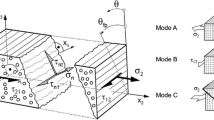Abstract
Laminated composites can undergo complex damage mechanisms when subjected to transverse impact. For unidirectional laminates it is well recognized that delamination failure usually initiates via intra-ply shear cracks that run parallel to the fibres. These cracks extend to the interface of adjacent orthogonal plies, where they are either stopped, or propagate further as inter-ply delamination cracks. These mechanisms largely determine impact energy absorption and post-delamination bending stiffness of the laminate. Important load transfer mechanisms will occur that may lead to fibre failure and ultimate rupture of the laminate. In recent years most Finite Element (FE) models to predict delamination usually stack layers of ply elements with interface elements to represent inter-ply stiffness and treat possible delamination. The approach is computationally efficient and does give some estimate of delamination zones and damaged laminate bending stiffness. However, these models do not properly account for coupled intra-ply shear failure and delamination crack growth, and therefore cannot provide accurate results on crack initiation and propagation. An alternative discrete meso-scale FE model is presented that accounts for this coupling, which is validated against common delamination tests and impact delamination from the Compression After Impact (CAI) test. Ongoing research is using damage prediction from the CAI simulation as a basis for residual strength analysis, which will be the published in future work.























Similar content being viewed by others
References
AIRBUS.: AITM1-0010 determination of compression strength after impact, (2005)
Sanchez-Saez, S., Barbero, E., Zaera, R., Navarro, C.: Compression after impact of thin composite laminates. Compos. Sci. Technol. 65, 1911–1919 (2005)
Davies A.O., Olsson R.: Impact on composite structures. Aeronaut. J, p. 541–563, (2004)
Choi, H.Y., Chang, F.-K.: A model for predicting damage in graphite/epoxy laminated composites resulting from low-velocity point impact. Int. J. Solids Struct. 26(26), 2134–2169 (1992)
Richardson M, Wisheart M.: Review of low velocity impact properties of composite material. Compos. A: Appl. Sci. Manuf. 1123–1131 (1996)
Finn, S.R., Springer, G.S.: Composite plates impact damage. Technomic Publishing Company, Inc. An Atlas, Lancaster (1991)
Abrate S.: Modeling of impacts on composite structures. Compos. Struct. 129–138 (2001)
Dahsin L.: Impact-induced delamination‐a view of bending stiffness mismatching. J. Compos. Mater., 674–692, (1988)
LLOrca, J., González, C.: Multiscale modeling of composite materials: a roadmap towards virtual testing. Adv. Mater. 23(44), 5130–5147 (2011)
Wisnom, M.: Modelling discrete failures in composites with interface elements. Compos. Part A 41, 795–805 (2010)
Park, K., Paulino, G.H.: Cohesive zone models: a critical review of traction-separation relationships across fracture surfaces. Appl. Mech. Rev. 64, 1–20 (2011)
Puck, A.: Festigkeitsanalyse von Faser-Matrix-Laminaten: Modelle für die Praxis. Hanser, München (1996)
Hashin Z.: Failure criteria for unidirectional fiber composites. J. Appl. Mech. 47, (1980)
Ladevèze, P., Lubineau, G., Violeau, D.: A computational damage micromodel of laminated composites. Int. J. Fract. 137(1–4), 139–150 (2006)
Allix, O., Ladevèze, P.: Interlaminar interface modelling for the prediction of delamination. Compos. Struct. 22, 235–242 (1992)
Dávila, C.G., Camanho, P.P., Turon, A.: Effective simulation of delamination in aeronautical structures using shells and cohesive elements. J. Aircr. 45(2), 663–672 (2008)
Batra R, Gopinath G, Zheng J. Damage and failure in low energy impact of fiber-reinforced polymeric composite laminates. Compos Struct. (2011)
Camanho, P., Davila, C.G., Moura, M.D.A.: Numerical simulation of mixed-mode progressive delamination in composite materials. J. Compos. Mater. 37(16), 1415–1438 (2003)
Pickett, A.K., Fouinneteau, M.R.C., P, M.: Test and modelling of impact pre-loaded composite panels. Appl. Compos. Mater. 16(4), 225–244 (2009)
Hillerborg, A., Modeer, M., Petersson, P.: Analysis of crack formation and crack growth in concrete by means of fracture mechanics and finite elements. Cem Concr. Res. 6(6), 773–781 (1976)
Shi Y, Swait T, Soutis C.: Modelling damage evolution in composite laminates subjected to low velocity impact. Compos. Struct. (2012)
Zhang X.: Impact damage in composite aircraft structures - experimental testing and numerical simulation. J Aerosp. Eng. 221–245 (1998)
Lammerant L, Verpoest I. Modelling of the interaction between matrix cracks and delamination during impact of composite plates. Compos. Sci. Technol. 1171–1178 (1996)
Moura, M.D.A., Gonclaves, J.: Modelling the interaction between matrix cracking and delamination in carbon?epoxy laminates under low velocity impact. Compos. Sci. Technol. 64(7–8), 1021–1027 (2004)
Zhang, Y., Zhu, P., Lai, X.: Finite element analysis of low-velocity impact damage in composite laminated plates. Mater. Des. 27(6), 513–519 (2006)
Bouvet, C., Castanié, B., Bizeul, M., Barrau, J.-J.: Low velocity impact modelling in laminate composite panels with discrete interface elements. Int. J. Solids Struct. 46(14–15), 2809–2821 (2009)
Geubelle P.H, Baylor J.S.: Impact-induced delamination of composites: a 2D simulation.Compos. Part B: Eng. 589–602 (1998)
Hallett, S., Green, B., Jiang, W., Wisnom, M.: An experimental and numerical investigation into the damage mechanisms in notched composites. Compos. Part A 40, 613–624 (2009)
esi-group.: Virtual Performance Soklution - Solver Referece Manual, (2012)
Deutsches Institut für Normung.: CFK Bestimmung energiefreisetzungsrate G1C-Test, Mai (1996)
Deutsches Institut für Normung.: CFK Bestimmung Energiefreisetzungsrate G2C-Test, April (1996)
W, N.A., P, A.K., Lourenco, N.S.F.: Mixed mode delamination - experimental and numerical studies. J. Strain Anal. 39(4), 153 (2003)
Camanho, P.P., Davila, C.G., Pinho, S.T., Remmers, J.J.C. (eds.): Mechanical Response of Composite, 10th edn. Springer, Berlin (2008)
Deutsches Institut für Normung.: Aerospace series - Carbon fibre laminates - Determination of the fibre-, resin- and void contents, August (1998)
Bowden, T., Reichert, J., Landolt, J.P.J.: The data acquisition system at the DCIEM impact studies facility. SAE Tech. Pap. 810812 (1981)
Acknowledgments
This publication is a result of a co-operation project between the national aeronautics and space research centre of the Federal Republic of Germany (DLR) and the University Stuttgart. The authors acknowledge the financial support received for this work from the Helmholz-Gemeinschaft and the state of Baden-Württemberg.
Author information
Authors and Affiliations
Corresponding author
Rights and permissions
About this article
Cite this article
Jäger, S., Pickett, A. & Middendorf, P. A Discrete Model for Simulation of Composites Plate Impact Including Coupled Intra- and Inter-ply Failure. Appl Compos Mater 23, 179–195 (2016). https://doi.org/10.1007/s10443-015-9455-2
Received:
Accepted:
Published:
Issue Date:
DOI: https://doi.org/10.1007/s10443-015-9455-2




